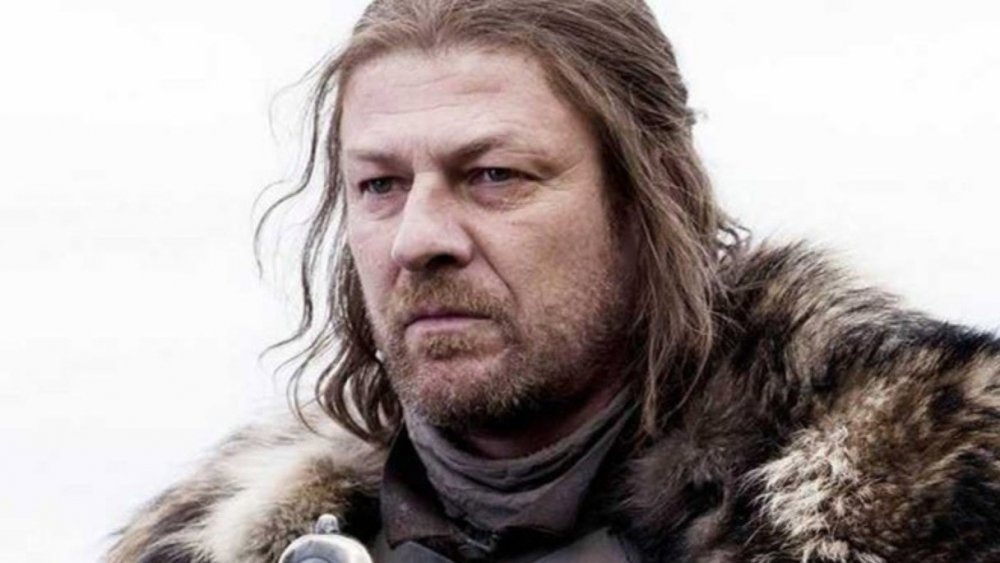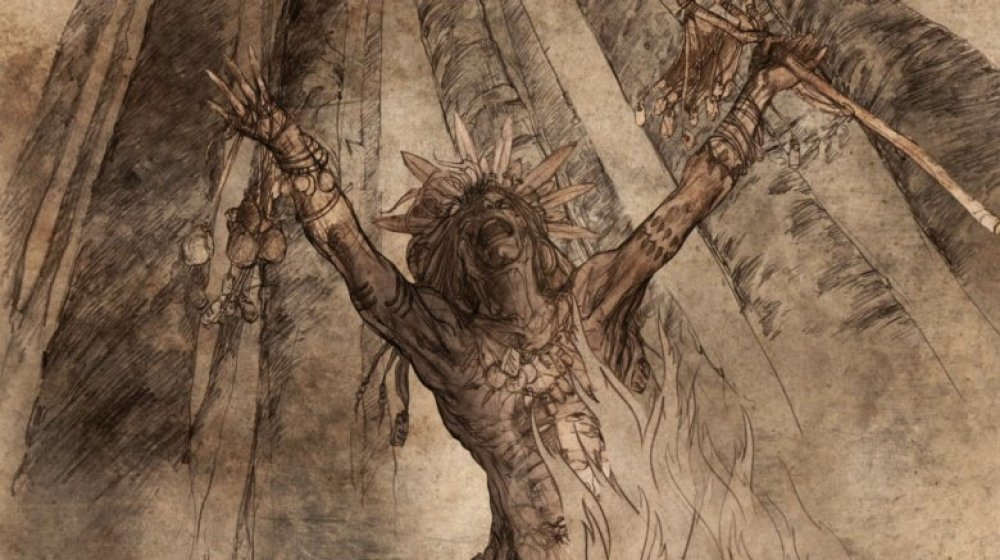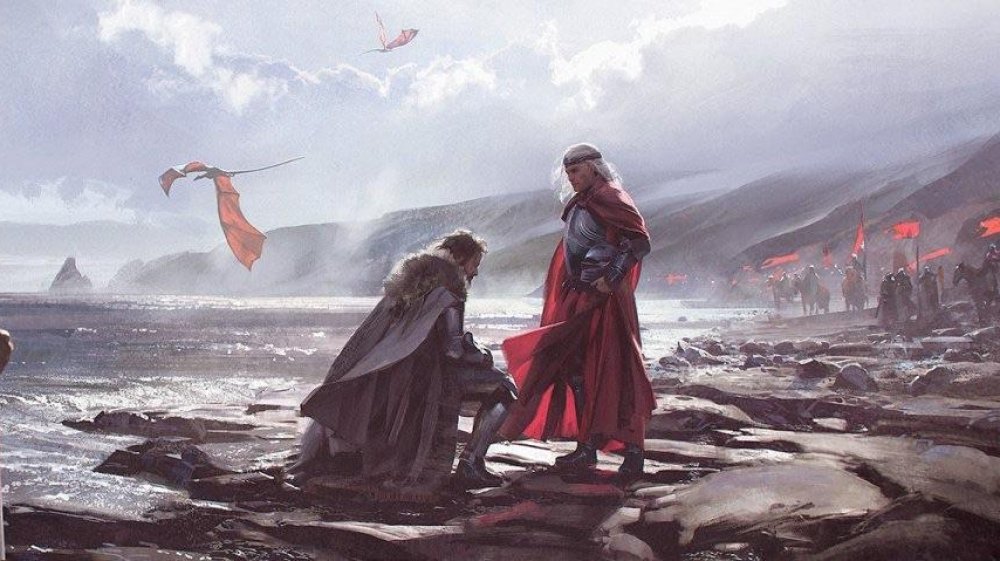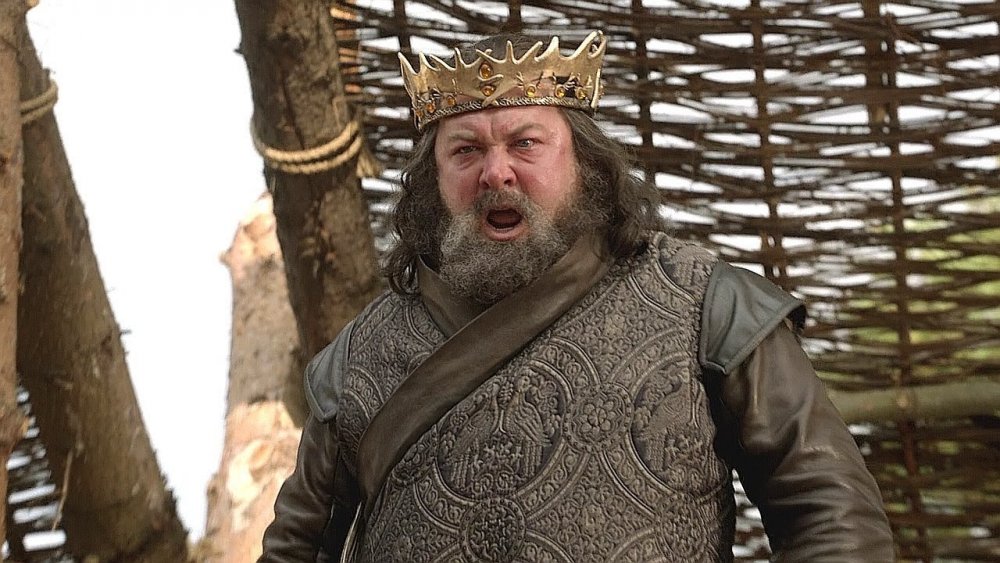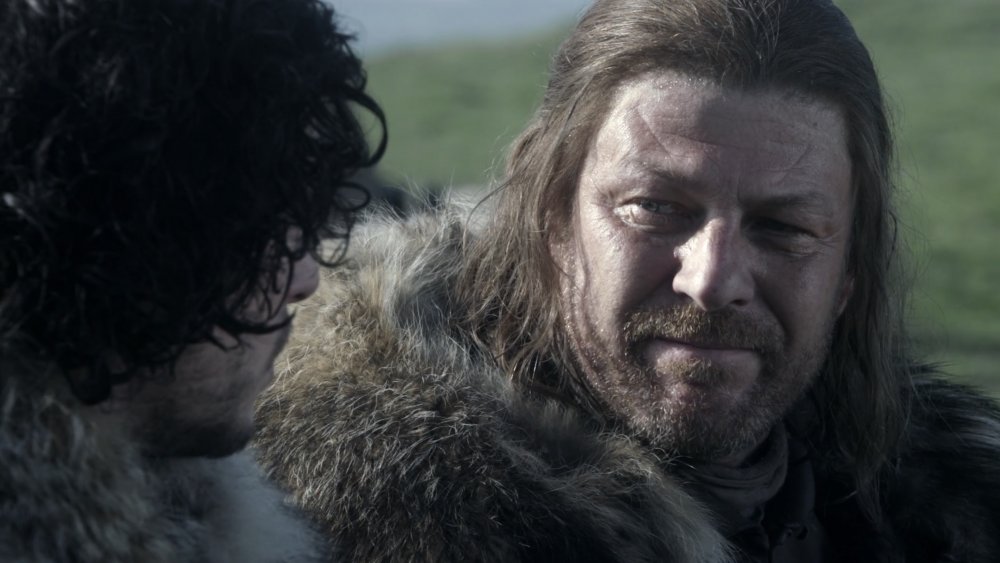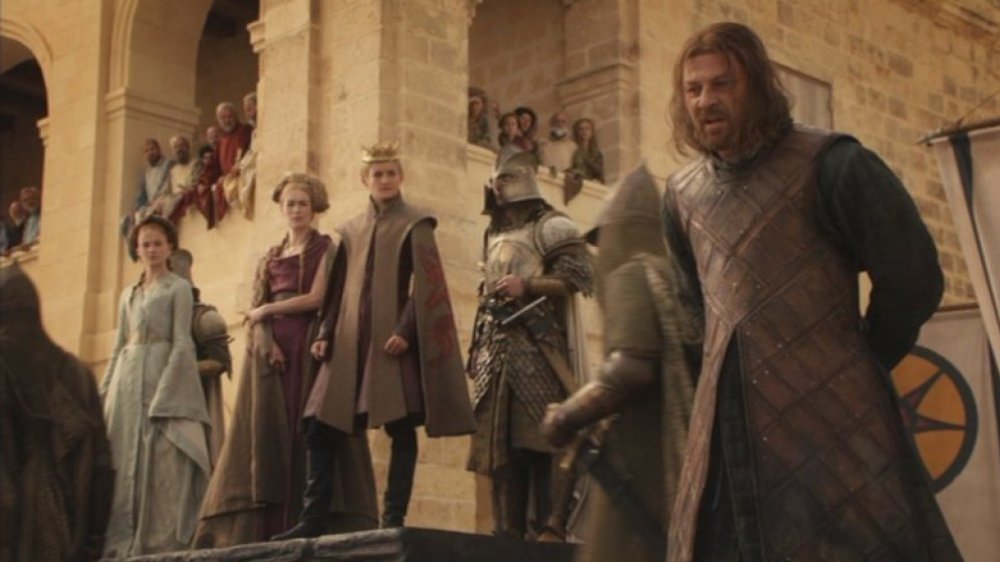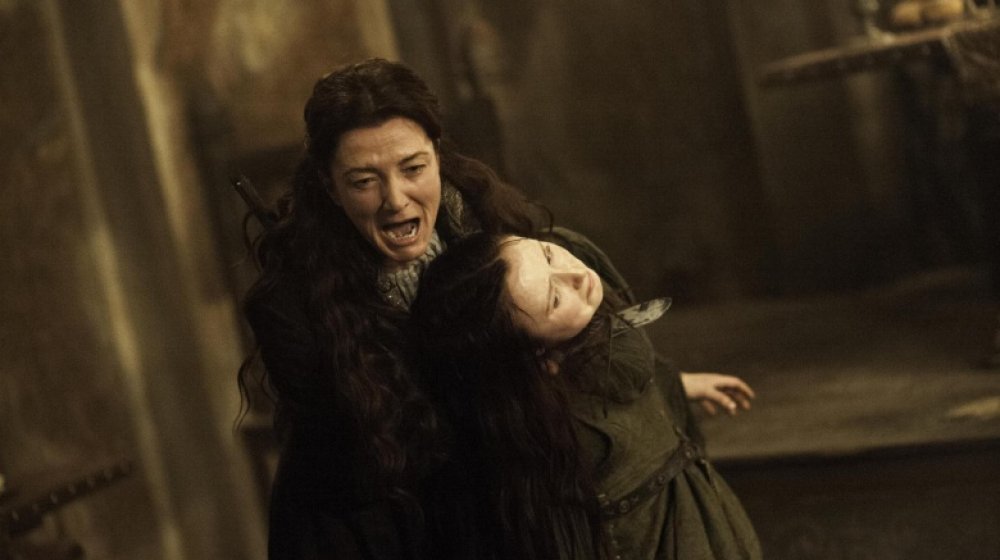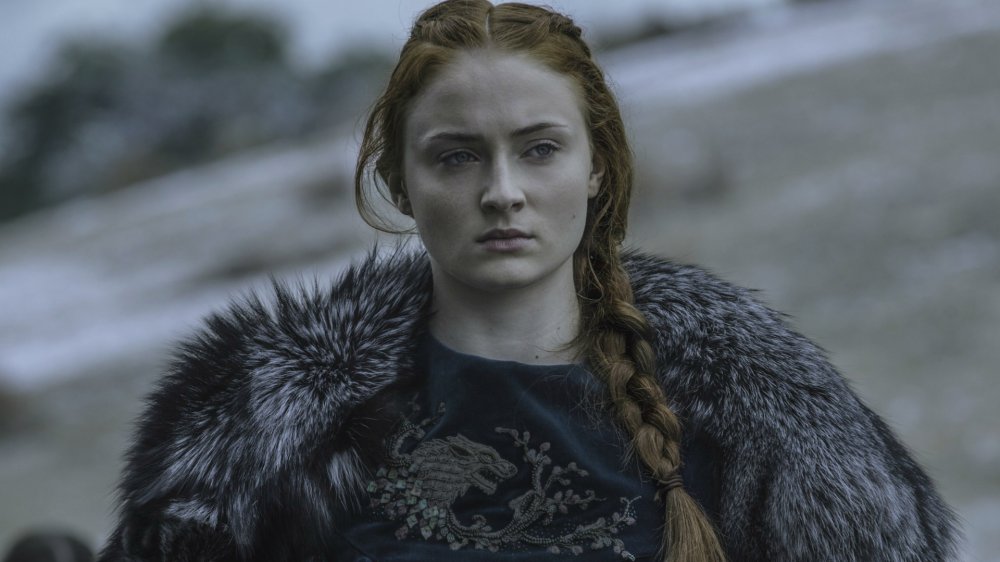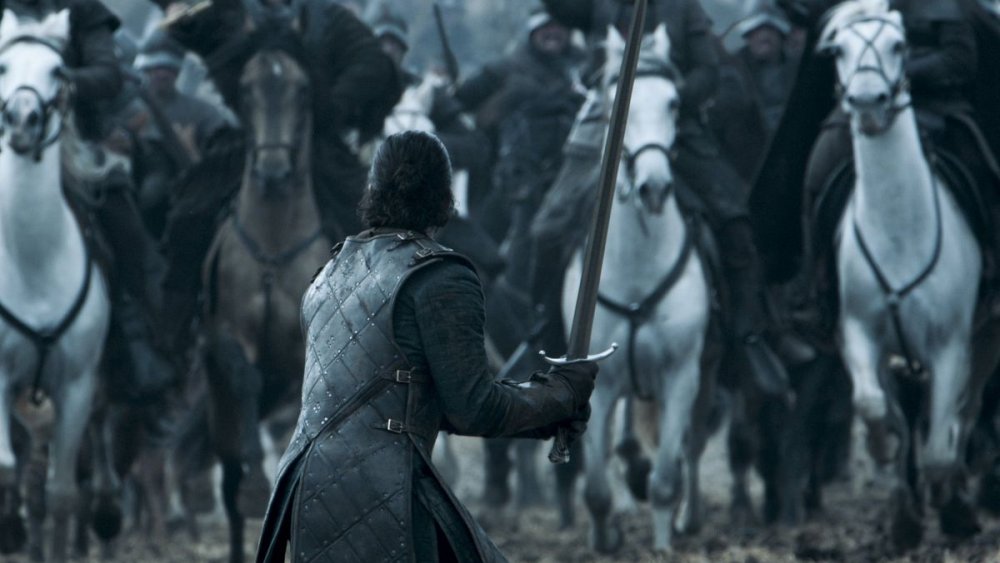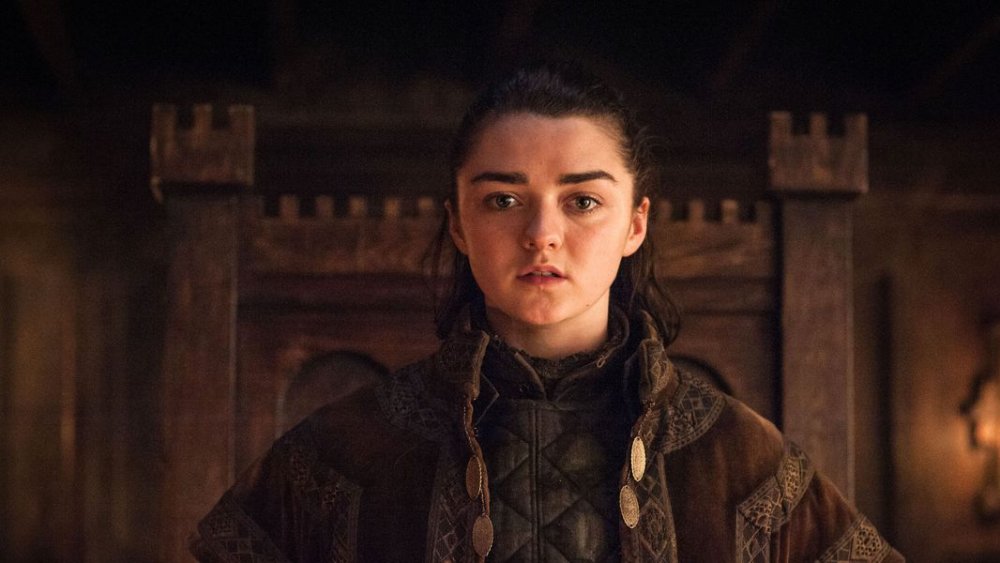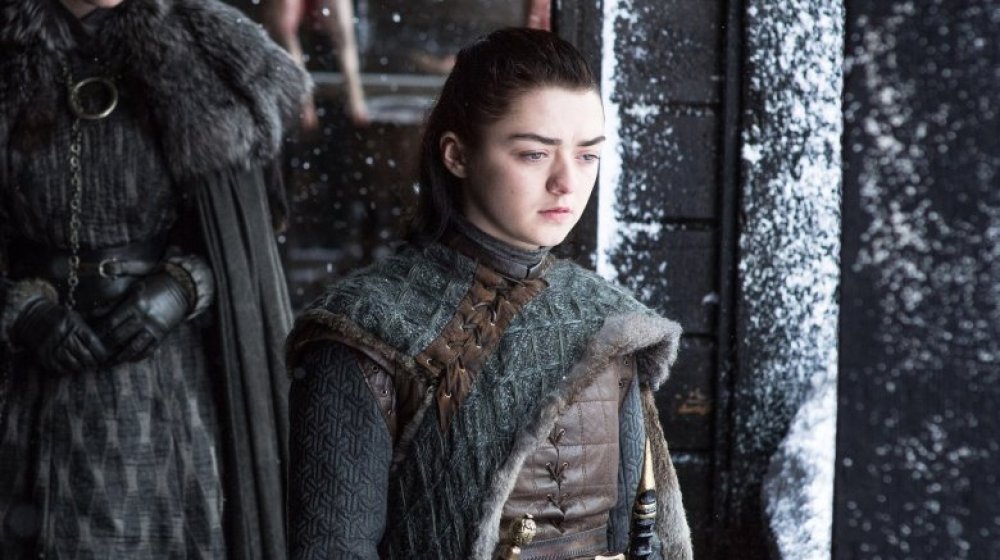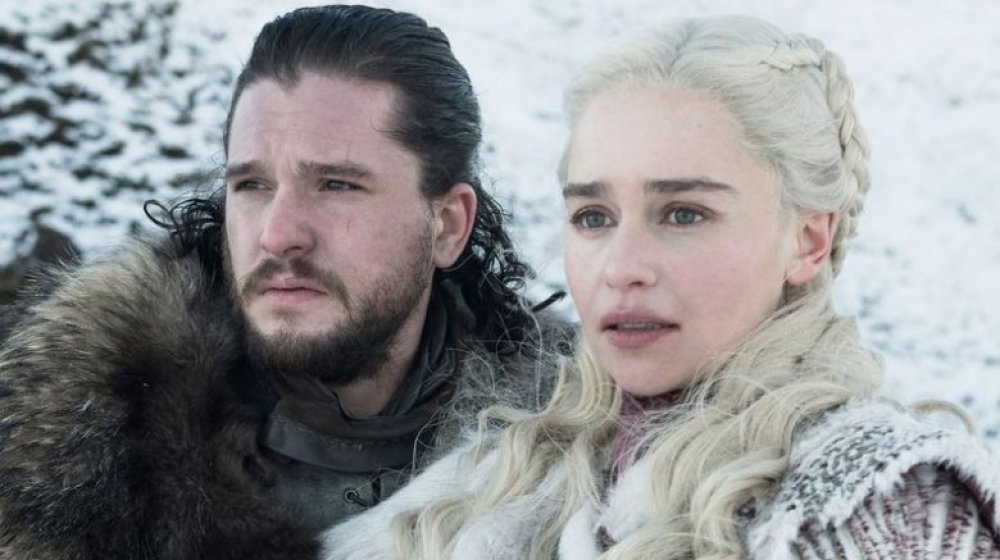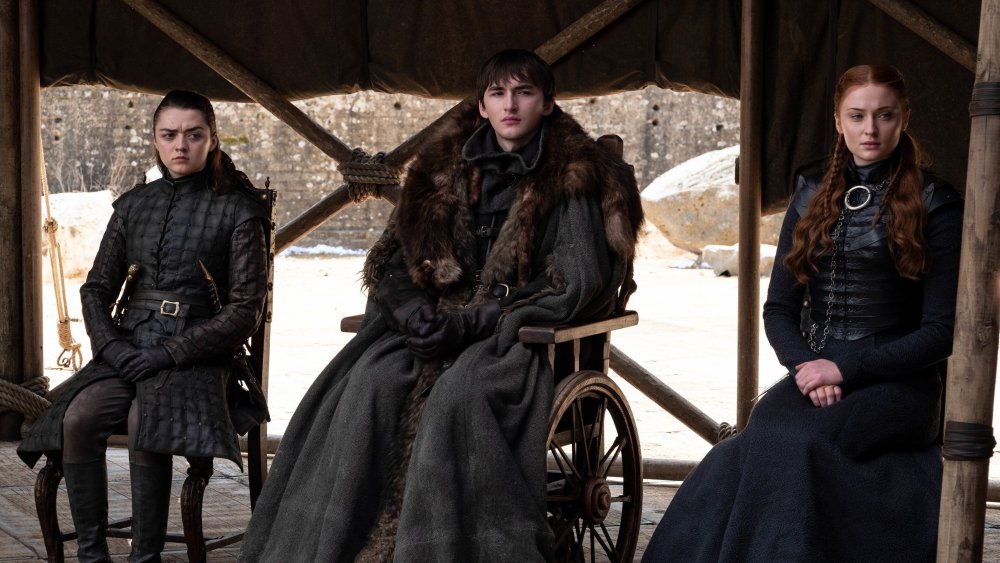The Entire House Stark Backstory Explained
It could be argued that Game of Thrones, HBO's juggernaut series that ran for eight seasons and was adapted from George R.R. Martin's series A Song of Ice and Fire, simply has too many characters. Throughout the series, it sometimes felt impossible to keep track of the enormous world populated by seemingly endless personalities (some of whom even had incredibly similar names), but in the end, four families loomed larger than the others — the Lannisters, Targaryens, Baratheons, and Starks.
Out of the four, the Starks may well be the most important to the series as a whole, considering that the entire show kicks off focusing on the ancient, noble Stark family of the northern region of Westeros. Plus, their motto, "winter is coming," provided one of the show's most famous taglines. Throughout Game of Thrones' epic run, fans followed the Stark family — patriarch Ned (Sean Bean), matriarch Catelyn (Michelle Fairley), and children Robb (Richard Madden), Sansa (Sophie Turner), Bran (Isaac Hempstead-Wright), Arya (Maisie Williams), Rickon (Art Parkinson), and half-Stark bastard Jon Snow (Kit Harington) — through every possible trial and tribulation, rooting for each of them along the way.
And yeah, the Starks have faced quite a few trials throughout their icy, bloody history. From their history before Thrones' narrative to their journey throughout the show, here's the entire backstory of House Stark explained. Spoilers for the entirety of Game of Thrones to follow!
The long history of the Starks in the North
Long before the events of Game of Thrones, the Stark family, which is one of the oldest bloodlines in all of Westeros, ruled over the North, just as they still do when Game of Thrones begins. As one of the most ancient Houses in the Seven Kingdoms, the Starks are descended from the First Men themselves — particularly Bran the Builder, a legendary First Man who served as the founder of House Stark and the first ever king in the North. The Starks also help to unite several squabbling First Men tribes under their rule, including the Boltons — who end up presenting a big problem much later on.
Houses like Mormont, Greyjoy, and Karstark also assemble under the control of the Starks, establishing the family as one of the most powerful in the realm. However, before long, a foreign invasion threatens their land.
King Torrhen Stark vs. the Targaryens
By the time that House Targaryen arrives to overtake the throne of Westeros, King Torrhen Stark is on the Northern Throne, but unfortunately, this particular king in the North is simply no match for the Targaryens' army, which, of course, contains dragons.
According to Westerosi legend, King Torrhen bravely marches south to meet the incoming Targaryen hordes, but he surrenders more or less immediately when faced with the enemy's oversized, vicious pets. As a thank you for surrendering, the Targaryen forces make Torrhen the paramount of the North, and they grant House Stark exclusive control of the area. Of course, this "reward" essentially gives the Starks control of the exact same region they ruled before, changing nothing, Torrhen's subjects are disappointed in their king's surrender — calling him the "king who knelt" — especially since other houses, including Gardener and Hoare, refused to bend the knee. Of course, those guys all got slaughtered. Torrhen may seem weak to his people, but he ensures the future of House Stark by giving up.
Robert's Rebellion
Though the Targaryens successfully rule Westeros for centuries, tensions between the royal family and their powerful subjects come to a head when Prince Rhaegar Targaryen, older brother of Daenerys (Emilia Clarke), apparently kidnaps Lyanna Stark (Aisling Franciosi), daughter of House Stark and sister to Ned, stealing her from Robert Baratheon (Mark Addy). In response, a vengeful Robert wages what later becomes known as Robert's Rebellion, overthrowing the Targaryens by slaughtering Rhaegar and killing Aerys II, Rhaegar and Daenerys' father, who's known as the "Mad King."
As a result, Robert becomes King Robert Baratheon and rules the Seven Kingdoms, but Ned, who personally apprehends Rhaegar at the Tower of Joy, is entrusted with a secret that he ends up keeping for the rest of his life. Rhaegar didn't kidnap Lyanna at all. The two were secretly married and had a son, Rhaegal, whose name and heritage put him in immediate danger.
Ned Stark heads to King's Landing
As the narrative of Game of Thrones begins, Jon Arryn — hand of the king to Robert Baratheon — suddenly and unexpectedly dies, leaving Robert without assistance. Unsurprisingly, he calls Ned Stark, one of his oldest friends and allies, to King's Landing to become his new hand. Ned brings along his daughters, Arya and Sansa — the latter of whom is meant to wed Robert's son, Prince Joffrey (Jack Gleeson) — while Catelyn, Robb, Bran, and Rickon remain behind at Winterfell.
Amidst rumors that Jon Arryn might've been murdered, Ned finds himself an unwilling part of the drama and intrigue of King's Landing, coming head to head with Cersei Lannister (Lena Headey), Robert's cold and conniving queen. After a hunch and some research, Ned discovers that Joffrey isn't Robert's true heir at all but the product of incest between Cersei and her twin brother, Jaime Lannister (Nikolaj Coster-Waldau). As a result, he shouldn't be in line for the throne. However, this information turns out to be much more explosive than Ned ever imagined.
The Starks scatter
Unfortunately for Ned, his discovery regarding Joffrey's real father is met with immediate pushback from the powerful Lannisters, especially after Robert dies in a hunting accident and Joffrey is crowned as the new king of the Seven Kingdoms. As retribution, Joffrey sentences Ned to death, and though he tells Sansa that he'll spare her father's life, he cruelly beheads Ned anyway. Arya makes a run for it, but Sansa, now a pawn in the Lannister's schemes, is a glorified captive in King's Landing.
When news of Ned's execution reaches Robb and Catelyn — who are already waging a war against the Lannister family, partly because Catelyn falsely believes that Tyrion Lannister (Peter Dinklage) tried to murder Bran, even though it was Jaime who pushed the boy from a tall tower — they vow revenge. As for Bran and Rickon, who are still at Winterfell, they're devastated. Before long, Bran and Rickon are forced to leave Winterfell and assumed dead when Theon Greyjoy (Alfie Allen) turns on the Starks and overtakes the castle. From there, the two youngest Stark boys head north, aided by wildling Osha (Natalia Tena) and Hodor (Kristian Nairn), the longtime, mostly mute strongman servant to the Stark family.
The Red Wedding shatters the Stark line
The Red Wedding is one of the most infamous events in Game of Thrones' storied history, and it's easy to understand why. During the third season, the Stark lineage is shattered seemingly beyond repair thanks to an old man's grudge and a broken promise, damaging this ancient house even further.
It all starts when Robb promises to marry one of Walder Frey's (David Bradley) many daughters if he helps Robb in his battle against the Lannisters, but when the young Stark falls in love with Talisa (Oona Chaplin) and marries her instead, Frey is absolutely incensed. Granted, everything seems above board when Walder agrees to marry his daughter to Catelyn's brother, Edmure Tully (Tobias Menzies), but the old man makes his real feelings clear at the wedding. In a shocking, brutal move, Walder orders the vicious slaughter of Catelyn, Robb, and a pregnant Talisa, as well as their army, in cold blood. In one swift move, two more Starks are lost, including Robb, the eldest son and king in the North.
Some of the Starks return to the North
In the aftermath of the Red Wedding, the remaining Starks, including Jon Snow, remain scattered to the winds, though most of them end up heading in the same direction. While Jon remains with the Night's Watch at the Wall, eventually breaking away from his brothers in black to infiltrate the wildlings and work with them, Bran and Rickon head in his direction and almost cross paths with him as Bran journeys to the far North so that he can fulfill his destiny of becoming the omniscient Three-Eyed Raven.
Meanwhile, after years on the road in Westeros, Arya leaves her companion, the Hound (Rory McCann), behind to travel to Braavos and train as a faceless assassin at the House of the Undying. Sadly, Sansa ends up with the worst fate of any of her surviving family members. After escaping the Lannisters in the wake of Joffrey's murder, Sansa is at the mercy of Petyr "Littlefinger" Baelish (Aidan Gillen), and he marries her off to Ramsay Bolton (Iwan Rheon), the recently legitimized and entirely sadistic heir to the Bolton family.
The Starks reclaim Winterfell
Sansa ends up brutalized and tortured at Ramsay's hands, but thankfully, when Theon, Ramsay's longtime captive, rebels against his master and helps her escape, she leaves Ramsay's clutches and reunites with Jon at the Wall. However, Ramsay still holds both Winterfell and Rickon, who he has as a captive, leaving Sansa and Jon no choice but to attack him to reclaim their family home.
This all leads to season's six's stunning showstopper, the Battle of the Bastards, which pits Jon against Ramsay in a fight for Winterfell and a fight to protect both Sansa and Rickon. Though Ramsay manages to murder Rickon before the battle even begins, Jon, along with an assist from Littlefinger's forces (thanks to Sansa's shrewd strategic mind), overcomes the Boltons and takes Winterfell back for the Starks. As for Sansa, she finally gets her revenge, feeding her abusive husband, Ramsay, to his own hungry dogs before triumphantly returning to her childhood home.
Revenge for the Red Wedding
While the Starks in the North learn to move through space and time (Bran) or wage war against invading forces to reclaim Winterfell (Jon and Sansa), one lone Stark sets off on her own, seeking revenge for the deaths of her mother and brother. Arya becomes a silent, faceless killer who can shift into any persona she wants. Armed with this new skill, the youngest Stark daughter sets out to avenge the North.
After returning to the Riverlands, Arya infiltrates the Frey household, serving several of Walder Frey's children to him in a pie before revealing herself as Arya Stark, slaughtering him, and stealing his face. Next, she cleanly disposes of the entire Frey clan by posing as Walder himself in the stunning season seven opener, reminding the sole survivor that "the North remembers" and that "winter came for House Frey." From the moment Arya watches her father's head leave his body, she is consumed with revenge, and in this devastating act against the Freys, she proves just how formidable she really is, proving she's capable of great yet dark acts.
A rift between the Stark sisters
After returning to Winterfell when she hears the news that her half-brother and sister have reclaimed the castle, Arya shows off just how much she's changed to a shocked Sansa, who seems both disgusted and surprised by Arya's hardened exterior. After learning to steal faces and going temporarily blind in the process, Arya is clearly a cold-blooded killer. On the flip side, Arya doesn't entirely trust Sansa's strategies or intentions. Ultimately, an apparent rift is created between Sansa and Arya, which Littlefinger realizes he may be able to play to his advantage.
However, unbeknownst to Littlefinger, the Stark sisters, along with their brother Bran — who, by now, is privy to pretty much all the universe's secrets as the Three-Eyed Raven — are plotting against him the entire time, and they ultimately put him on trial for numerous crimes against House Stark. Littlefinger is then sentenced to death and killed using the Valyrian steel dagger that once belonged to him, dying at Arya's hands as the Starks gain more power and strength by banding together.
Jon's true parentage is revealed
As the story of Game of Thrones begins to draw to a close and its power players draw closer together, one of the show's biggest mysteries is revealed — specifically, the identity of Jon Snow's mother. As it turns out, Jon isn't Ned Stark's bastard at all, but instead, he's the legitimate product of the marriage between Lyanna Stark and Rhaegal Targaryen. Ned simply pretended that Jon was his bastard, born from an affair with a tavern girl, to protect him. If Robert had ever found out that Jon was a Targaryen and the true heir to the throne, he would've had the infant slaughtered without hesitation.
Obviously, this complicates things quite a bit, especially considering that Jon eventually strikes up a romantic relationship with Daenerys — who's his aunt — and can now challenge her for a place on the Iron Throne. Ultimately, what it does mean is that the Stark family, one of the oldest families in the realm, has a half-Stark, half-Targaryen card to play.
The Starks end the series on top
When all is said and done, there's no question that the Stark family, which has seen so much strife and bloodshed, ends Game of Thrones at the top of the pack. After Arya single-handedly takes down the Night King using her deadly skills, the Starks, including Jon, help Daenerys battle the Lannister forces at King's Landing. However, when it becomes obvious to all of them that Daenerys is a ruthless tyrant, Jon kills his aunt and lover, leaving the fate of Westeros in question.
Ultimately, the Starks come out on top when Bran, who, according to Tyrion, has the "best story," is crowned king, with Sansa retaining independence of the North and becoming its queen. With Jon rejoining the Night's Watch alongside the wildlings, Arya exploring whatever might be west of Westeros, Sansa crowned queen in the North, and Bran serving as Bran the Broken, the Starks prove their resilience and power. Happy endings in Game of Thrones are hard to come by, but it could be argued that the surviving members of the Stark family gets the happiest possible ending.
